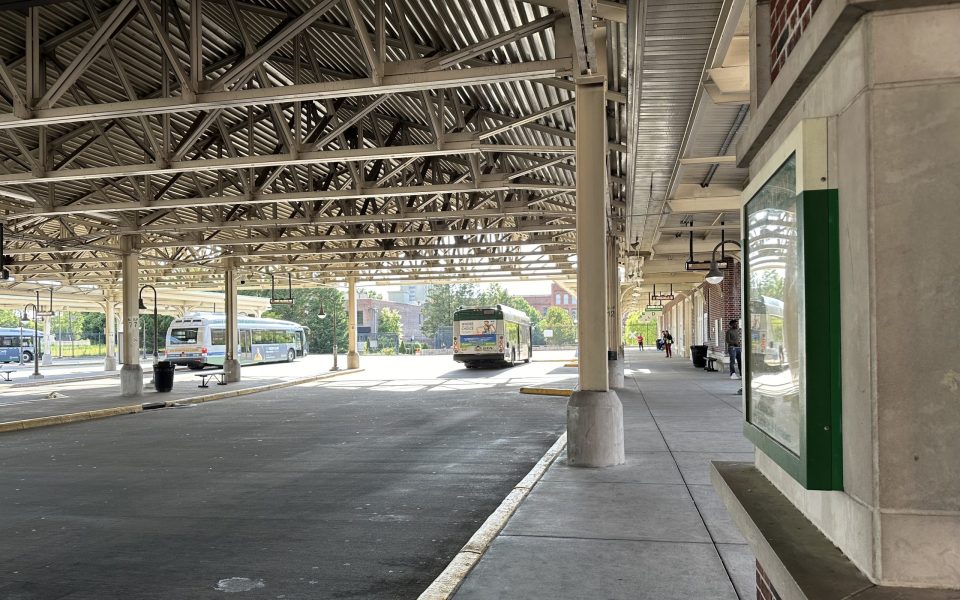Featured photo: Buses drop off and pick up passengers at Greensboro’s J. Galyon Depot, a transit hub downtown. (Photo by Gale Melcher)
As the last few hours of Thursday’s sunny afternoon slipped away and cars muttered in evening traffic, hordes of buses were still rolling in and out of Greensboro’s downtown J. Galyon Depot with a rumbling hum. One passenger with packed bags peered down the street before running to catch his bus. Others rested against the brick wall of the depot while they waited for a bus to take them home after a long day of work.
William Johnson has ridden buses all his life. Now he’s retired, but still rides GTA every day to get around town. A GTA bus ticket is $1.50, and that’s “expensive,” Johnson told TCB while waiting for his ride. “Buses should be free,” he suggested while a bus roared into the station.
To help riders like Johnson, the city of Greensboro is working towards a plan to make the city car-optional by 2045, including plans to potentially increase bus routes in the city. In order to make those plans a reality, the city is looking towards local funding.
In September, the city launched GoBORO’s public input phase and announced two concepts, one that focused on ridership and more frequent service and another on increasing coverage across the city.
On Wednesday morning, Greensboro Transit Agency Director Reginald Mason explained the next steps of the plan. Mason and transit staff are working alongside consultant Scudder Wagg with Jarrett Walker + Associates, a transit-planning firm that works with cities and transit agencies across the world.
They reached out to “thousands of people across Greensboro,” Wagg said on Wednesday, adding that the “majority” of respondents — 52 percent — preferred the ridership option.
The city currently has one route that runs every 15 minutes, while the draft of the city’s plan has five.


On Monday, the city received $3.25 million in grant funding from the Federal Transit Administration to decrease wait times on Route 15. The Yanceyville/Brightwood School Road route will now run at 30-minute frequencies instead of one hour. Riders can now expect buses every 30 minutes on all GTA daytime routes, except for Crossmax Purple which has service every 15 minutes. The funding will also go toward buying four new clean diesel buses. In addition to federal funding, money from a potential county-wide half-cent sales tax will be crucial fuel for the expansion, Wagg explained. It could rake in around $45 million per year, but it would require the approval of voters via a countywide referendum.
As for a sales tax to fund transit, stuff at the corner store already costs a pretty penny, Johnson posits. Still, he didn’t have complaints about the bus service itself. The people are nice, too, he added.
A few steps away from Johnson, Angel Smith waited for a bus with a friend. Smith rides the bus every day, but whether that bus gets to its destination “on time” is an issue. Safety is another thing on Smith’s mind. While the bus drivers are “really respectable” and “cool,” some of the passengers make Smith feel unsafe and wish there were more security.
In an interview with TCB, Mason noted that they’re a couple years away from putting the half-cent tax on a ballot.
Once the plan is finalized, they’ll “start talking about when is a good time to put it on the ballot,” he said. If it doesn’t pass, they’re “going to have to look at some other ways of funding GoBORO if [they] really want to change the landscape of transit here in Greensboro,” Mason said.
With the funding, service in Greensboro could be increased by 100-120 percent, 150-170 percent in High Point and 160-190 percent in Guilford County. PART service could increase by 80-100 percent.
The city calculates that the tax would cost the average household $9 per month. According to the city’s survey, 47 percent of respondents said that they would “definitely” give their support to a sales tax for transit investment while 80 responded that they were likely to do so.

“Think about how much you might save if you could live with one less car, or no car,” Wagg said. The American Automobile Association estimates that the average cost of owning a car amounts to more than $10,000 annually.
“There’s vast potential savings for many, many people,” he added.
Wagg explained that people in poverty could be connected to 118 percent more jobs than they have access to now. With the new GoBORO plan, 70,700 jobs or 43 percent of all jobs in Greensboro could be near transit that arrives every 15 minutes. Also, it would bring 15-minute wait times to 30 percent of the city’s residents.
The changes would offer “more access to jobs, more access to retail,” Mason said. It’s about “connecting communities” and creating “economic viability for those who don’t have cars, who need public transportation to get to work a lot quicker than they do right now,” he added.
The city is currently seeking feedback on the draft plan by June 30. After including public input as well as input from GTA staff, the city’s mayor and councilmembers, the plan will be finalized this summer, Wagg said.
All CityBeat reporting content is made possible by a grant from the NC Local News Lab Fund, available to republish for free by any news outlet who cares to use it. Learn More ↗
Republish this storyJoin the First Amendment Society, a membership that goes directly to funding TCB‘s newsroom.
We believe that reporting can save the world.
The TCB First Amendment Society recognizes the vital role of a free, unfettered press with a bundling of local experiences designed to build community, and unique engagements with our newsroom that will help you understand, and shape, local journalism’s critical role in uplifting the people in our cities.
All revenue goes directly into the newsroom as reporters’ salaries and freelance commissions.


Leave a Reply